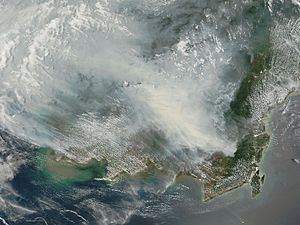Mega Rice Project facts for kids
The Mega Rice Project was a huge plan started in 1996 in Kalimantan, which is the Indonesian part of Borneo. The main idea was to change a million hectares (that's about 2.5 million acres!) of peat swamp forest into rice farms.
Indonesia's government wanted to grow more food because its population was getting bigger. They spent a lot of money building canals and cutting down trees. However, the project failed and caused a lot of harm to the environment. It was eventually stopped.
Contents
What Was the Mega Rice Project?
The peat swamp forest in southern Kalimantan is a very special place. It is home to many rare animals, like orangutans, and slow-growing but valuable trees.
Understanding Peat Swamp Forests
A peat swamp forest is a unique ecosystem. It has tall tropical trees growing on a thick layer of peat. Peat is made of partly decayed and waterlogged plant material. This layer can be 10 to 12 meters (about 33 to 39 feet) deep! Underneath the peat is soil that isn't very fertile.
Peat holds a lot of carbon. When peat is broken down or burned, it releases CO2 into the air. This adds to global warming. Unlike forests in colder places that can grow back in 10 to 30 years, peat swamp forests might take hundreds of years to recover.
How the Project Changed the Forest
Before 1997, people were slowly clearing parts of the peat swamp forests for small farms. But most of the original forest was still there. In 1996, the Indonesian government started the Mega Rice Project (MRP).
Between 1996 and 1998, workers dug more than 4,000 kilometers (about 2,500 miles) of drainage and irrigation channels. They also started cutting down trees. Some logging was legal, but much of it involved burning the forest.
The new water channels, roads, and railways made it easier for illegal loggers to enter the area. Because of this, the forest cover in the MRP area dropped a lot. In 1991, about 64.8% of the land was forest. By 2000, it was only 45.7%. Forest clearing has continued since then. It seems almost all the valuable trees have been removed from the project area.
Problems Caused by the Project
Before the project, these forests often flooded up to 2 meters (about 6.5 feet) deep during the rainy season. But after the canals were dug, the surface of the peat became dry all year round.
Because of these problems, the government stopped the Mega Rice Project. However, the now-dry peat is very easy to catch fire. Huge fires continue to break out in the area.
The destruction of the peat forest also causes sulfuric acid pollution in the rivers. During the rainy seasons, the canals release acidic water into rivers. This water contains a lot of pyritic sulfate. This pollution can travel up to 150 kilometers (about 93 miles) upstream from the river mouth. This might be why fewer fish are being caught in these rivers.


